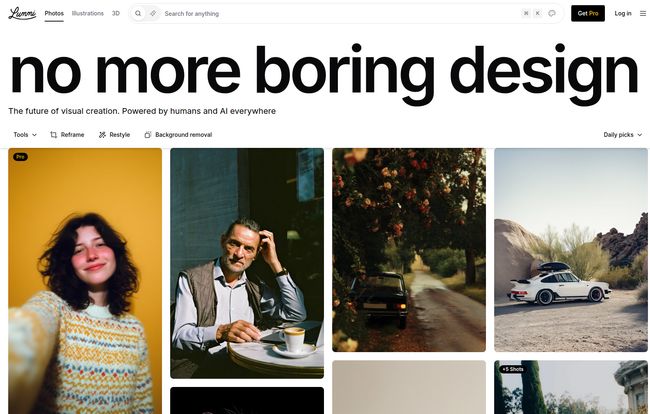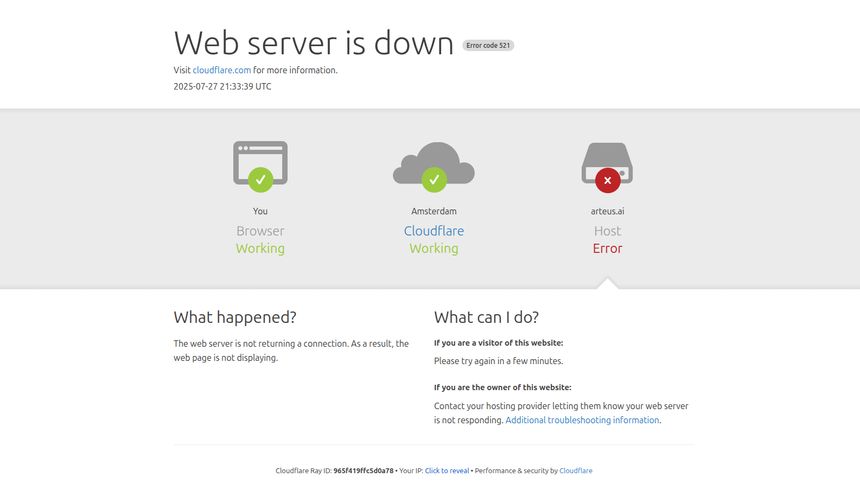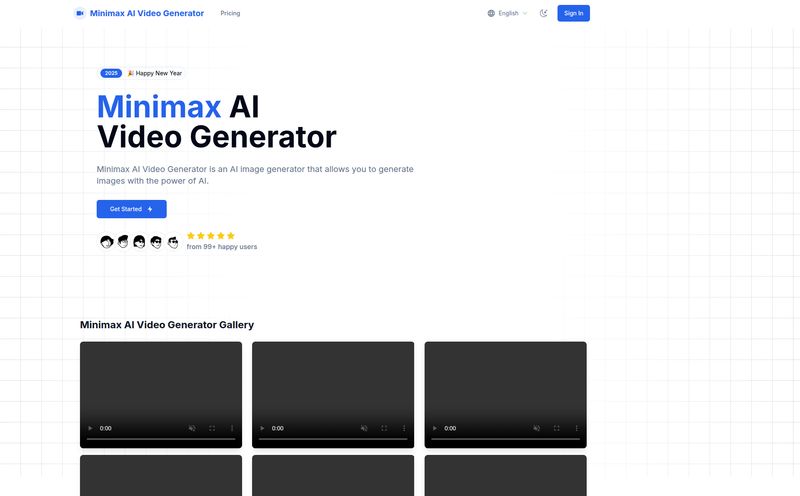How many hours of your life have you lost scrolling through stock photo sites? You know the ones. The endless sea of impossibly cheerful people in business suits high-fiving, the perfectly staged flat lays, the woman laughing alone with a salad. It’s a creative soul-crushing experience. For years, my content creation process felt like panning for gold in a river of digital mud. You find something okay, but rarely something that makes you go, “Wow.”
So when I stumbled upon Lummi and its bold claim of “no more boring design,” my inner cynic raised an eyebrow. Another one? But then I clicked through. And I kept clicking.
What I found wasn't just another repository of generic visuals. It felt different. It felt… curated. Artistic, even. And the secret sauce? It’s powered by a blend of human creativity and artificial intelligence. Yeah, I know. The term “AI” gets thrown around more than a frisbee at a park these days, but this felt like a genuinely interesting application. So, is Lummi the answer to our stock photo prayers, or just another tech gimmick?
So What is Lummi, Exactly?
At its core, Lummi is a library of over 13,000 (and growing) stock images, illustrations, and 3D assets. The big twist is that these aren't your typical photoshoots. They are, as Lummi puts it, “AI-crafted images from global creators.” This positions it as a sort of middle-ground in the wild west of AI image generation. It's not a free-for-all prompt-based generator like Midjourney, but a curated gallery of high-quality, ready-to-use visuals born from AI.
Think of it less like a sprawling warehouse store (like, say, Shutterstock) and more like a boutique art gallery. Every piece feels intentional. The collection is full of moody portraits, atmospheric landscapes, and bizarrely beautiful still-life shots that you just won't find on Pexels or Unsplash. It’s a breath of fresh air, honestly.

Visit Lummi
A First-Hand Look Inside the Lummi Library
My first impression browsing the site was… quiet awe. The images have a certain texture and depth. You’ll find a close-up of a capybara that looks like a renaissance painting, a sun-drenched portrait of a woman in a knit sweater that feels incredibly candid, and abstract architectural shots that bend reality just a little bit. It’s a mix of stunning portraits, weirdly beautiful abstracts and landscapes that feel both real and not.
The quality is impressive. Gone are the waxy, slightly-off hands and six-fingered anomalies that plagued early AI image generators. Most of these images are indistinguishable from high-end photography. It's clear there’s a heavy human touch in the selection process, weeding out the digital weirdness and presenting only the best results. This curation is, for me, its biggest selling point.
The Big Features That Actually Matter to Creatives
A pretty gallery is nice, but workflow is king. As a blogger and designer, I need tools that make my life easier, not just prettier. Lummi seems to get this, and there are a couple of features that really stood out to me.
That Sweet, Sweet Figma Integration
Okay, this one got me excited. For anyone living in Figma day-in and day-out (like me), this is huge. Lummi offers a native Figma plugin that lets you search and drop their entire library directly into your designs without ever leaving the app. This is a massive time-saver. No more downloading an image, saving it to a folder, importing it into Figma, and then positioning it. You just find what you want and bam, it’s in your canvas. I've used similar plugins for other stock sites, and Lummi's is just as smooth and intuitive. It's one of those small things that adds up to a huge quality-of-life improvement.
Royalty-Free Licensing Without the Headaches
Licensing can be a minefield. Can I use this for a client? Does it need attribution? What about for a t-shirt? Lummi cuts through the noise with a straightforward royalty-free license. This means you can use the images for both personal and commercial projects without paying extra or jumping through legal hoops. In a world where the legality of training data for AI models is a hot-button issue, having a platform take a clear stance on commercial usability is a major plus.
The Elephant in the Room: The AI Content Debate
Let's not sidestep the controversy. The rise of AI-generated art has sent shockwaves through the creative community. Some argue it devalues the work of human photographers and illustrators. And it's a valid concern. I've always championed supporting real artists and photographers.
My take on Lummi? It feels less like a replacement and more like a new kind of tool. The platform is built on images from “global creators,” suggesting a collaborative model where prompt-artists or AI artists are contributing to the library. It's not just a faceless algorithm. However, one of the noted cons is that AI content can sometimes lack that undefinable human touch. While many of Lummi’s images are incredible, you might occasionally find one that feels a little too perfect, a little too sterile. It's a trade-off. You gain incredible speed and variety, but you might lose a bit of the soul found in a photo captured in a real, fleeting moment.
So, What’s the Catch?
No tool is perfect, right? While I’m pretty high on Lummi, there are a few things to keep in mind. First, you need to log in to get full access, which is a minor annoyance but pretty standard. Second, while the overall quality is high, it can vary. Not every image is a masterpiece, and you’ll still need a good eye to pick the winners. It’s curated, but your personal taste is still the final filter.
The biggest question mark for me, though, is the pricing.
How Much Does Lummi Cost?
This is the million-dollar question, and right now, it's a bit of a head-scratcher. The website doesn't have a public pricing page that I could find. There is, however, a very prominent “Get Pro” button on the site. This strongly suggests a freemium model is in play. My guess? You can probably browse and use a selection of images for free (perhaps in lower resolution or with certain limitations), with a paid “Pro” subscription unlocking the full library, higher resolutions, and maybe other premium features.
I personally prefer this model. Let me try the service, fall in love with the workflow, and then ask for my money. It shows confidence in the product. But for now, the exact cost remains a mystery.
My Final Word: Is Lummi Worth Your Time?
After spending a good amount of time with it, I've gotta say, I'm impressed. Lummi is a thoughtfully designed platform that solves a real problem: the overwhelming blandness of traditional stock photography. It provides visuals that are unique, artistic and genuinely inspiring.
Is it for everyone? Probably not. If you’re a photographer, you might view it with skepticism. If you need a very specific, literal photo of, say, “two business people shaking hands in a boardroom in Ohio,” a traditional site might still be faster. But for bloggers, social media managers, UI designers, and small agencies who crave a distinct visual style without the custom photoshoot budget, Lummi is a powerful new contender. It's a sign of where things are heading—a future of design that is, thankfully, a lot less boring.
Frequently Asked Questions About Lummi
- What is Lummi?
- Lummi is a platform offering a curated collection of AI-generated stock photos, illustrations, and 3D assets. It focuses on providing unique, artistic, and high-quality visuals for creative projects.
- Are Lummi images really free to use?
- The images on Lummi are offered with a royalty-free license, which means you can use them for personal and commercial projects without paying royalties for each use. While browsing appears to be free, they have a “Get Pro” option, suggesting a paid tier for full access or higher-quality downloads.
- How is Lummi different from Midjourney or DALL-E?
- While Midjourney and DALL-E are AI image generators where you create images from text prompts, Lummi is a curated library of pre-made AI images. You search and browse a collection rather than generating images yourself. This saves time and ensures a consistent level of quality.
- Does Lummi have a Figma plugin?
- Yes, and it's one of its best features! The Lummi Figma plugin allows you to search and insert images directly into your Figma designs, which is a major workflow enhancement for designers.
- Can I use Lummi images for my business's marketing?
- Yes, their royalty-free license allows for commercial use, making the images suitable for marketing materials, websites, social media, and other business-related projects.



